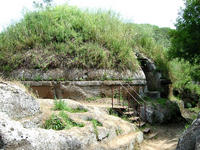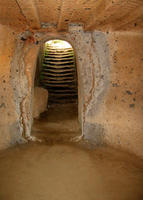You are in: Europe -> Italy -> Etruscan Necropolise... , and traditional search or Image Gallery will yield results of this site only
Etruscan Necropolises of Cerveteri and Tarquinia
| Site number: | 1158 |
|
| Type of site: | Cultural | |
| Date: | 9th-1st cent.BC | |
| Date of Inscription: | 2004 | |
| Location: | Europe, Italy, Region of Latium, Provinces of Rome and Viterbo | |
Up to 75 images are shown here. Click on each for more details or on Image Gallery for more images.
| Description: | Bearing witness to the accomplishments of Etruscan culture, the site’s two large Etruscan cemeteries display different manners of burial practices from the 9th to the 1st century BC. Over a period of nine centuries the earliest urban civilization in the northern Mediterranean developed here. A number of the tombs are colossal, cut in rock and crowned by striking tumuli (burial mounds). Several of them incorporate wall carvings; others have wall paintings of stupendous quality. The necropolis known as Banditaccia, close to Cerveteri, holds thousands of tombs structured in a city-like plan, complete with streets, minute squares and neighbourhoods. The tombs come in various types: as trenches cut in rock; tumuli; and in the shape of huts or houses, also carved in rock, with affluent structural detail. These supply the only surviving evidence of Etruscan residential architecture. The necropolis of Tarquinia (also called Monterozzi) encloses 6,000 rock-cut graves; it is renowned for its 200 painted tombs, some dating as far back as the 7th century BC. --WHMNet paraphrase from the description at WHC Site, where additional information is available. | |
| Cerveteri is a town and comune of the northern Lazio, in the province of Rome. Originally known as Caere, it is famous for a number of Etruscan necropoleis that include some of the best Etruscan tombs anywhere. The most famous attraction of Cerveteri is the Necropoli della Banditaccia, which has been declared by UNESCO a World Heritage Site together with the necropoleis in Tarquinia. It covers an area of 400 ha, of which 10 ha can be visited, encompassing a total of 1,000 tombs often housed in characteristic mounds. It is the largest ancient necropolis in the Mediterranean area. The name Banditaccia comes from the leasing (bando) of areas of land to the Cerveteri population by the local landowners. --Wikipedia. Text is available under the Creative Commons Attribution-ShareAlike License. | ||
| Source: | http://whc.unesco.org/en/list/1158 | |
| Reference: | 1. UNESCO World Heritage Center, Site Page. | |
















